-
August 31, 2019 by Total Fire and Safety

Once again active shooting in public places is making headlines and making us consider our self defense options wherever we go. Unfortunately, our safety can be threatened almost anywhere, and self-defense is important. In your workplace or the facilities you manage, it’s important for the people inside to know how to react in the event of an active shooter or other attack.
In the case of an active shooter or other violent attack, potential victims have little or no advance warning. The sound of gunshots may be the earliest alert you receive, leaving little time to react. That’s why it is more important that you are prepared with a proactive plan of self defense, so you know how to respond immediately.
For years we were taught to shelter in place and wait for first responders. But studies have found that this line of defense results in increased casualties. Recently, offices and buildings have adopted the ALICE response plan. ALICE is an acronym for the five steps you can take to survive an active shooter attack. You may or may not use all the steps in the plan, but it’s nice to know that the fire extinguishers we regularly install and service, can actually be used effectively against an attacker in the “C” or “counter” step of ALICE.
So, in the event of an attack, remember ALICE:
- Alert- Let everyone in the office or the building know what is going on when you hear gunshots, receive a warning or phone message, etc. The faster you communicate, the more lives can be saved.
- Lockdown- If evacuation is not an option, lock the door, barricade it, and cover windows. Look for alternate escape routes, call 911, but do not open the door. Prepare yourself for the shooter to enter.
- Inform- Pass on as much information as you can. Who, what, where, when! The more those around you know, the better.
- Counter- Counter is one of the most dangerous but potential life saving strategies within the ALICE response. To counter is to fight back. Even in schools, there is one weapon, available to all, allowed and required in all buildings, and easy to use at your disposal against a predator. It’s your FIRE EXTINGUISHER!
While any object can become a weapon against the shooter, that five or ten-pound fire extinguisher on the wall can be very powerful. Remember that an armed assailant will not have a free hand to block counterattacks, nor will they be expecting one. Use your fire extinguisher to throw at the shooter or as a bludgeon when he comes through the door. Even if hitting him over the head does not knock him unconscious, it can buy you time to escape. You can also pull the pin and deploy the contents which can potentially blind or suffocate the shooter, or at the very least, startle him/her, long enough to disarm or tackle them.
To use a fire extinguisher, remember PASS:
- Pull the pin. Hold the extinguisher with the nozzle pointing away from you and release the locking mechanism.
- Aim low. Point the extinguisher at the base of the fire.
- Squeeze the lever slowly and evenly.
- Sweep the nozzle from side-to-side.
Once the can is empty, keep your grasp and ram the bottom of the can into the attacker’s face or body. Having training on how to correctly use a fire extinguisher ahead of time can ensure that your employees are prepared for more than fighting fires!
If you automatically locate the nearest escape doors when you go into a public place, it’s also a good time to note where the fire extinguishers are located, just in case.
The last letter in the ALICE acronym is “E.”
- Evacuate- Escaping the danger zone is always the best self defense option in the event of a shooter. Total Fire & Safety offers emergency evacuation and fire safety training so your people are trained to respond in a productive, organized way should an emergency ensue.
Total Fire and Safety is committed to all areas of life safety, including self defense against active shooters. For more information on our training, see our website or give us a call: 630-960-5060.
Category: Business Safety, Fire Extinguishers, Fire Extinguishers, Fire Safety, Health and Safety Tags: employee training, fire and safety equipment, Fire Extinguisher, fireextinguisher, Fireextinguishertraining, firesafetytraining, lifesafety, safety, Self Defense, Total Fire and Safety | Comments Off on When Self Defense Meets Fire Safety
-
June 19, 2019 by Total Fire and Safety
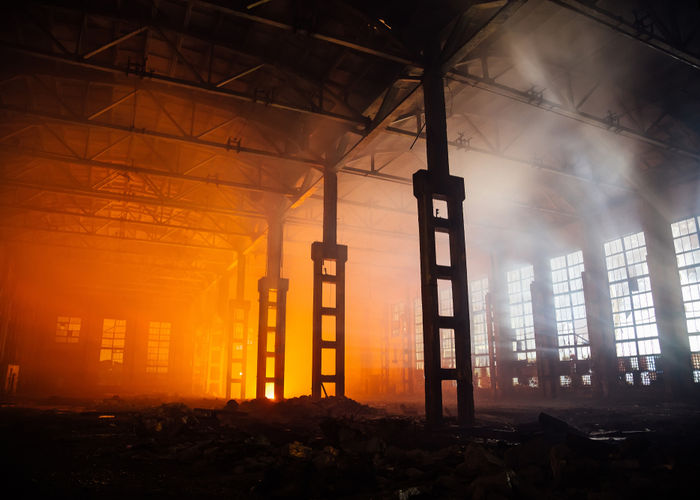
According to legend, the cause of the greatest fire in Chicago was a cow kicking over a lantern in a barn. In 1871, the entire city of Chicago was engulfed in flames. The fire lasted two days, left 300 people dead and over $200 million in damage. The event changed Chicago. Stricter fire codes were implemented, structures were built with different materials, and fire departments were equipped with better equipment and advanced training methods.
Today, fires in Chicago rarely go unexplained due to investigative divisions within the fire departments. The investigative teams are well trained in how to identify common causes of fires in Chicago. The most common causes of fires in Chicago vary by type.
Common Causes of Residential Fires
- Overusing extension cords
- Overusing Christmas lights/stringing them together under furniture
- Smoking materials (cigarettes, cigars, etc.…)
- Heating or electrical malfunction
- Cooking or kitchen fires
Common Causes of Industrial Fires
- Combustible dust
- Hot work
- Flammable gas or liquid
- Equipment and machinery fires
- Electrical hazard fires
How Fires are Investigated
Whether it is a residential fire or industrial fire, criminal or accidental, fires in Chicago and around the country all have a determining factor. The responsibility for finding the determining factor is up to the fire department. From a public standpoint, finding a cause seems impossible. How do they do it?
Upon arriving at the scene, firefighters note the color of the flames, the amount of smoke, the rate at which the fire spreads, and the sound it makes. These are all clues as to what is burning and how it is burning. It is incumbent of the firefighters to protect the evidence at the scene by:
- Limiting excessive fire suppression
- Preventing needless destruction to a property
- Using markers or cones to identify evidence
- Writing notes or making voice recordings of observations
- Covering areas that contain evidence
- Preserve delicate evidence like shoe or tire tracks
Once the fire is extinguished, the fire investigators dig through the ashes. They take photographs prior to and during the investigation for documentation. The objective of investigators is to locate the point of origin. This is achieved through the char patterns, direction of melt, and heat shadows. The burn patterns are often “V” shaped like an inverted cone. The fire burns upward, in a V-shaped pattern away from point of origin. The location is usually the most damaged by the fire. Although most of the determination of origin is science-based, there is a little bit of guessing and witness accounts. Fires in Chicago are likely to have one of four reasons:
- Electrical issues
- Natural acts
- Open flames
- Human action
Fires in Chicago have decreased over the years with an average of eight fire per day. Fortunately, fatal fires are rare, but even one is too many. It’s important for residents and businesses to practice fire safety. Is your business well equipped against fires? Total Fire and Safety can help safeguard your building and those occupying it with fire alarms, fire extinguishers, first aid kits, emergency lights and more. We’ll inspect your property to ensure it is up to code and even provide training classes for employees so they know how to use the equipment in an emergency. Give TFS a call today at 630-960-5060.
Category: Business Safety, Fire Extinguishers, Fire News, Fire Safety Tags: commercial fire protection, commercial fire safety, fire and safety solutions, Fire Extinguisher, fireextinguisher, firesafetytraining | Comments Off on In the Aftermath: Finding the Causes of Fires in Chicago
-
December 4, 2018 by Total Fire and Safety

A brand new year is a great time for businesses to evaluate what they can improve upon, even in terms of their commercial fire safety. No business is completely immune to accidental fires and having the right equipment in place year round can prevent potential devastation.
According to the National Fire Protection Association (NFPA), more than 3,300 fires break out in office buildings across the U.S each year. The NFPA reports that a number of people are killed or injured with an estimated $112 million in property damage.
If you’re a business set on achieving your 2019 goal of reaching NFPA compliance, take a look at checklist of equipment you need below for commercial fire safety. Anything missing? Call Total Fire & Safety. We can help!
____ Alarms
____ Extinguishers and Suppression Systems
- Conduct tests regularly to ensure function and pressure when activated.
- Schedule routine maintenance of equipment.
- Store extinguishers in open areas for easy access.
____ Emergency Lighting
- Effective emergency lighting throughout the building will help occupants to safety in an emergency.
- Schedule regular maintenance and inspections.
Equipment is essential and necessary to prevent major damage but people are too! Whether it’s putting out a fire or tending to the injured, what good is the equipment if you don’t have employees able to use it?
____ First Aid
____ Training Courses
- A comprehensive fire equipment training course on the use of fire equipment and first aid can place confidence in employees and keep everyone safe.
- Training employees reduces the chance of small fires starting and spreading.
You could have all the equipment ready and employees trained to use it but they need something else.
____ Emergency Preparedness Plan
- Remind employees to REACT-(remove from danger, ensure doors/windows are closed, activate alarm, call 911, treat as dangerous.)
- Conduct fire drills.
- Schedule inspections of all fire equipment.
- Have employees trained on firefighting equipment.
Making sure you have commercial fire safety in place can seem a daunting task but the pros at Total Fire and Safety are here to simplify it. TFS covers everything including inspection, maintenance, training, and keeping your building up to code so you are well protected in the event of an unforeseen fire. Give us a call today at 630-960-5060.
Category: Business Safety, Fire Alarm Monitoring, Fire Equipment Inspections, Fire exits, Fire Extinguishers Tags: commercial fire protection, commercial fire safety, commercial first aid kit, emergency exit lights, emergency lighting, fire and safety solutions, Fire Extinguisher, fire safety, fire safety training, fireextinguisher, firesafetytraining, firesprinklerinspections, first aid | Comments Off on The Business Owner’s Checklist for Commercial Fire Safety in 2019
-
November 5, 2018 by Total Fire and Safety

Next to the everyday hustle and bustle of the average office, office kitchen fire safety is a secondary concern. However, the National Fire Protection Agency (NFPA) reports that just over one-fifth of office fires begin in the kitchen or cooking area. Twenty-nine percent are started by cooking equipment, the leading cause of fires in the office. Although these fires started small, they caused major structure damage.
With the holidays on the way and more employee parties sure to take place, the office kitchen will be used more than ever. How can you prevent a fire from happening? How do you keep your employees safe and well fed at the same time? Here are four important safety tips to help you get started:
1. Replace worn or frayed power cords.
Inspect power cords on the kitchen appliances. Are the wires exposed? If so, the cord can short out and cause a fire. Encourage your employees to keep an eye out for damaged cords. Be sure to replace them as soon as they are found. This one simple act will keep the office safe.
2. Watch food as it cooks.
It easy to become distracted in the office, whether its fellow coworkers gossiping or doing too many things at once. You wouldn’t leave food unattended at home and the office should not be any different. To ensure food cooks properly, emphasize that employees must stay near appliances as they cook or heat food/beverage. Employees using the kitchen also need to watch for signs of smoke or burning. Doing so will ensure the safety of the entire building.
3. Regularly clean appliances.
We’ve all been there. We stick a (insert food item) in the microwave, oven, toaster, etc., and it explodes or leaves spillage behind. However, we avoid cleaning, commonly thinking someone else will do it. Spills and baked-in foods left behind can cause a fire. Cleaning kitchen equipment after use will prevent grease from accumulating which prevents combustion. These hazards can be avoided easily so remind employees to wipe up spills, food particles left behind, etc.
4. Have employees trained to use a fire extinguisher.
No matter how proactive you and your employees are, accidents still happen. Having staff trained to use fire fighting equipment could mean the difference between a catastrophe or a minor incident. Total Fire and Safety can train you and your employees to use a fire extinguisher, first aid equipment, and other lifesaving safety measures.
With most office fires starting in the kitchen, it is important to educate employees on office kitchen fire safety. Total Fire and Safety (TFS) offers a complete fire training program to educate employees on the proper techniques of fighting a fire. Not only can your employees use these practices in the office, they can also apply them in their home. Keep you, your staff, and your workplace fire safe. Give TFS a call today at 630-960-5060.
Category: Business Safety, Fire Extinguishers, Fire Safety, First Aid, First Aid Kits Tags: commercial fire safety, fire and safety equipment, fire and safety needs, fire and safety solutions, Fire Extinguisher, fire safety, fire safety solution, fireextinguisher, firesafetytraining, first aid | Comments Off on Danger on the Job: Keeping the Office Kitchen Safe
-
March 21, 2018 by admin
Join us for the 2018 Fire Safety Symposium
at Total Fire & Safety!
Register below! Space is limited!
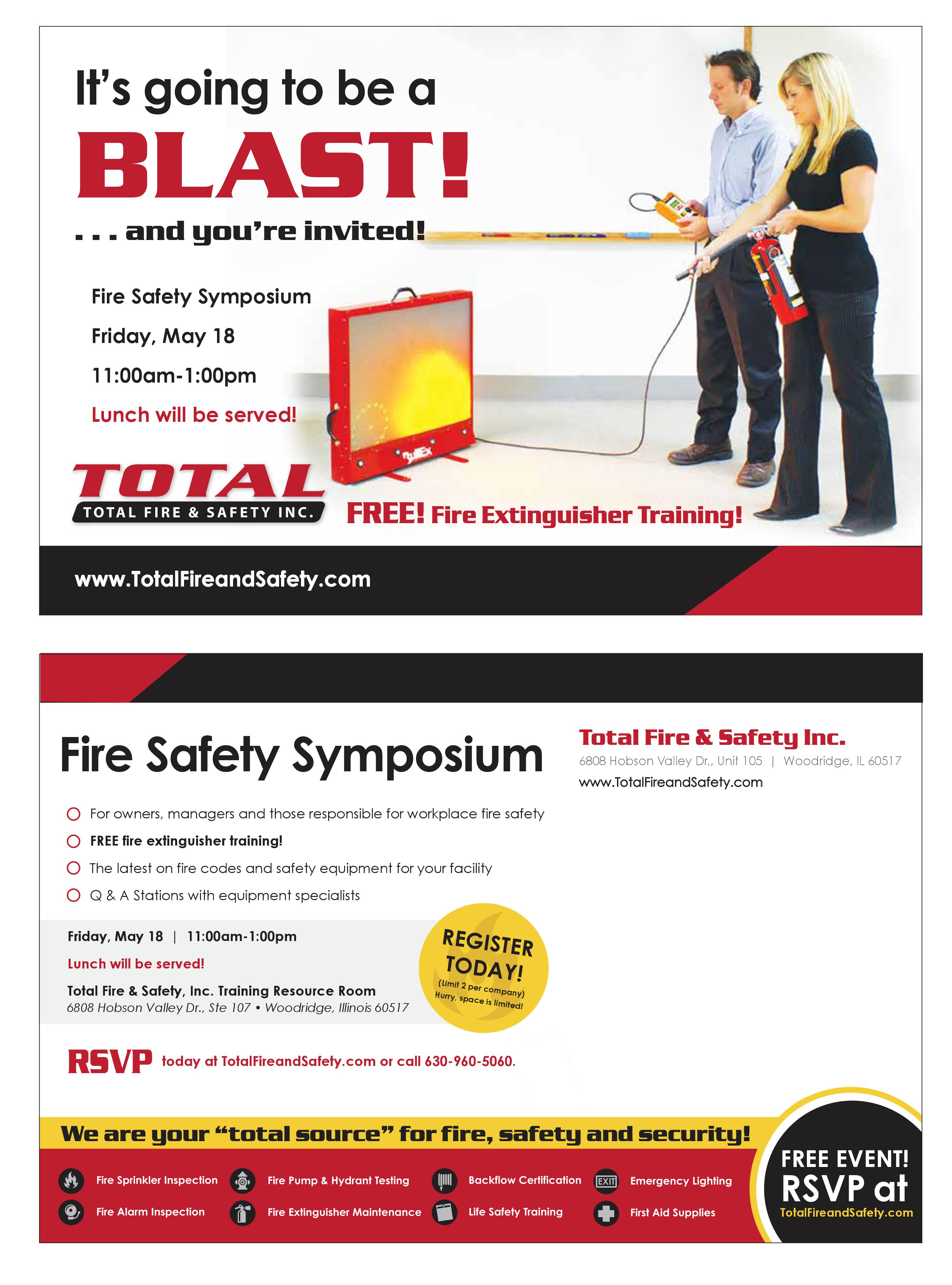
Category: Business Safety, Client Events, Fire Extinguishers, Fire Extinguishers, Fire News, Fire Safety Tags: commercial fire safety, employee training, fire and safety equipment, fire and safety solutions, Fire Extinguisher, fire safety, fireextinguisher, Fireextinguishertraining, Total Fire & Safety, Total Fire and Safety, training | Comments Off on Fire Safety Symposium
-
January 15, 2018 by Total Fire and Safety
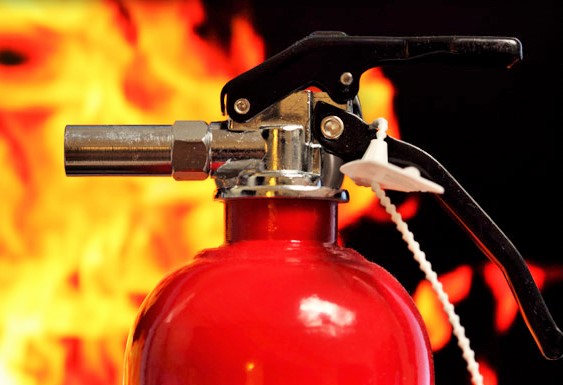
There’s no better way to ring in the new year and make sure your business is ready for any emergency 2018 brings than with proper fire extinguisher service at all of your locations. The National Fire Protection Association (NFPA) states that all portable fire extinguishers be inspected on a monthly basis and maintained by a licensed fire protection company on an annual basis. Yet each year nearly 25,000 fires cost companies over billions of dollars from not only recovery of property and premises but worker’s compensation filings and lawsuits from employees. Sometimes damages could have been reduced if employees had been aware of and actually used the fire extinguishers available.
Properly working fire extinguishers are a first line of defense against fires and can significantly minimize damage until help can arrive. Total Fire and Safety provides a thorough inspection that begins when we walk in the door, and continues throughout the building. Our fire extinguisher service contains our twelve-point check. What are the 12 points?
- Visual examination: We ensure the device is free of dents, rust, corrosion, and other related hazards.
- Test/Maintenance history: We review the test/maintenance history to ensure the internal system is active.
- Pressure Gauge: We check the pressure gauge to confirm the compression in the tank.
- Weight: We make sure the right amount of fluid is inside the tank.
- Discharge hose: We remove it and inspect for irregularities.
- Locking pin: We check for ease of removal in the event of a disaster.
- Handle/Lever: We ensure that the handle/pin will discharge smoothly.
- Clean Extinguisher: We degrease any pertinent areas.
- Inspection certification: We attach a safety flag and service tag to signify when service was completed.
- Extinguisher: We return it to the designated location.
- Mounting Bracket: We secure the extinguisher on its mount correctly.
- Hazard Application: We confirm you have the proper extinguisher type installed for your application.
Hand in hand with having extinguishers is teaching your employees how to use them. That’s why Total Fire & Safety also offers training courses for your employees/tenants so that in the case of an actual emergency, they will not hesitate to reach for the fire extinguisher.
Fire extinguishers are not only legally required but also give employees piece of mind, especially if they know how to use them. Employees appreciate working for a company that has their safety in mind. However, fire extinguisher service is definitely key.
If your fire extinguishers need service or are due for an inspection, please don’t hesitate to contact us at contact us at 630.960.5060.
Category: Fire Equipment Inspections, Fire Extinguishers, Fire Extinguishers, Fire Safety Tags: commercial fire safety, Extinguisher, fire and safety equipment, fire equipment inspection, Fire Extinguisher, fire extinguisher inspection, fire safety, fireextinguisher, Fireextinguishertraining | Comments Off on Is it time for Fire Extinguisher Service?
-
June 17, 2015 by Total Fire and Safety
All fires and fire extinguishers are not created equal. It is important, especially in a commercial setting, that a business has the right kind of fire extinguishers available and ready to go for the most probable fires. Fires are classified five ways (see chart below). While a restaurant may be most concerned with Type K fires, a manufacturing plant may be concerned with B or D.
According to the NFPA, the materials which ignite the most industrial fires are flammable liquids and gases, and electrical wire or insulation. These materials are common in industrial settings, so be sure to follow all fire safety recommendations, and know what kind of fire extinguishers are best to have on hand in the workplace.
Here is a chart that explains which type of fire extinguishers work for each type of fire. Of these fires, only one (type A) can be extinguished with water. The rest require special ingredients that cut off oxygen in different ways, therefore, it’s important to have the right kind of extinguisher on hand.
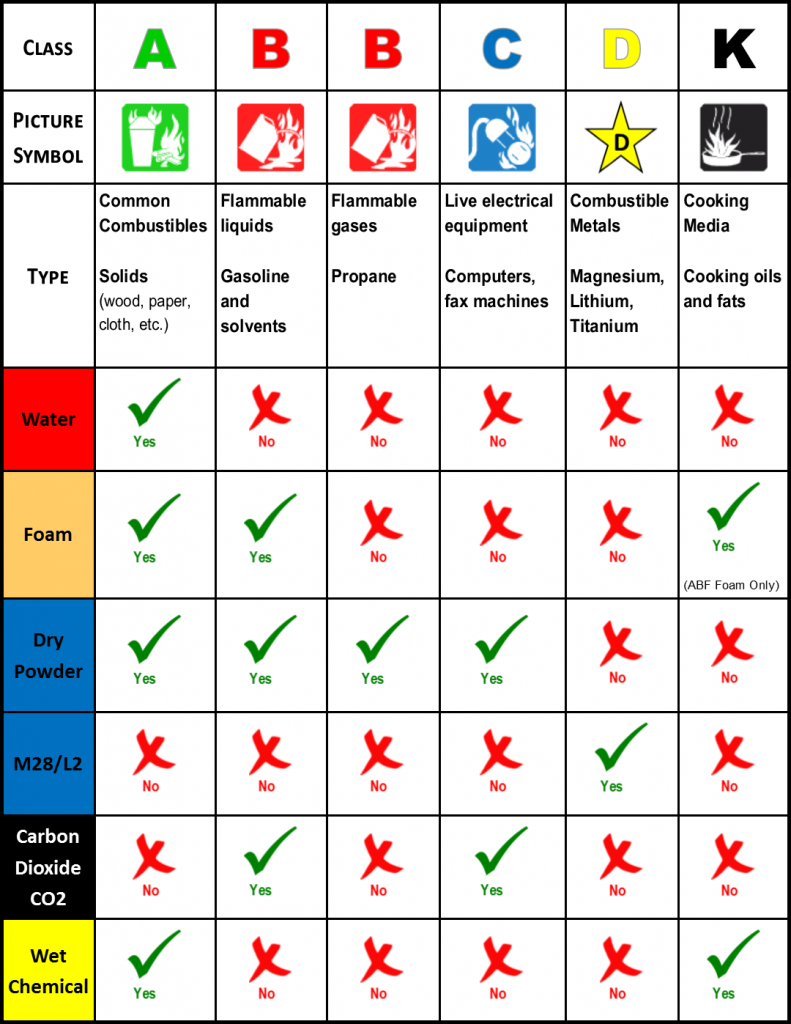
Once you have the correct extinguisher in place, it’s also important to make sure that you have regularly scheduled fire extinguisher inspections and that your employees have correct fire extinguisher training. Total Fire and Safety offers fire extinguishers for every type of fire. If you have any questions about the type of extinguisher you should have onsite, or current extinguisher maintenance issues, please feel free to contact us at 630.960.5060
Category: Fire Extinguishers Tags: Fire Extinguisher, fireextinguisher, Fireextinguishertraining, firesafetytraining | Comments Off on Do You Know What Type of Fire Extinguisher Your Business Needs?
-
May 11, 2013 by Total Fire and Safety
Effective Training
We can simulate A, B and C class fires at four difficulty levels and have the capability of grading trainees on their performance. Hundreds of trainees can be trained in a single day without weather restrictions, EPA environmental issues or the mess of using conventional training methods.
Safe Atmosphere
Total Fire & Safety Inc. incorporates the latest technology, utilizing digital flames with laser or water training extinguishers.
Program Advantages
- Makes training to OSHA requirements safe and easy
- Allows training to take place entirely indoors: in the conference room, hallways, or in the actual work environment where the emergency would potentially take place
- Has the ability to grade users, making it easy to monitor improvement and proficiency
- No toxic waste or extinguisher residue left behind after training is complete
- A burn permit is not required while eliminating the hazards associated with conventional fire extinguisher training.
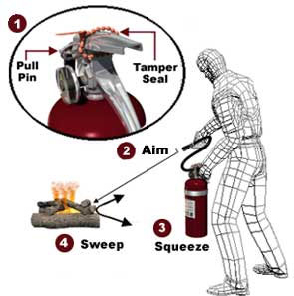
Category: Uncategorized Tags: Extinguishertraining, fireextinguisher, Fireextinguishertraining, firesafetytraining | Comments Off on Fire Equipment Training
-
March 12, 2013 by admin
Using state of the art technology, our Total Fire & Safety service team uses custom built reports that include voice data, photos, and apply all AHJ and state applicable codes. This ensures that your
company’s fire protection equipment has been tested properly.
Our service technicians go through extensive training in order to receive their state certifications. We hold regular in house safety meetings and continuous education programs to ensure that our technicians are always up to date on all the newest codes and standards.
In fact, our management team does regular onsite audits to ensure the job has been done correctly.
12-Point Portable Fire Extinguisher Service Check:
- Visual Examination: performed on the entire unit, carefully inspecting for dents, rust, corrosion, pitting or other shell damage
- Test/Maintenance History: reviewed to determine the need for required internal maintenance or hydrostatic testing
- Pressure Gauge: checked to ensure that the unit is fully pressurized
- Weight: the extinguisher is checked to ensure the correct amount of extinguishing agent is in cylinder
- Discharge Hose: removed to inspect for signs of blockage or damage
- Locking Pin: removed to ensure that the pin is easily removed in the event of an actual fire emergency
- Handle/Lever: checked for smooth discharge operation
- Clean Extinguisher: using a degreasing solution
- Inspection Certification: documented by attaching a safety flag and service tag indicating the work performed
- Extinguisher: returned to the proper location
- Mounting Bracket: checked to ensure extinguisher is installed securely on correct mounting hook or bracket
- Hazard Application: reviewed to make sure that the fire extinguisher is the correct type for a potential fire hazard
Category: Fire Extinguishers, Fire Safety Tags: businesssafety, equipment, Extinguisher, fire, Fire Extinguisher, fireextinguisher, safety, technology, training | Comments (1)
|

|
|
|
|
|
|

 Facebook
Facebook
 Instagram
Instagram
 LinkedIn
LinkedIn







